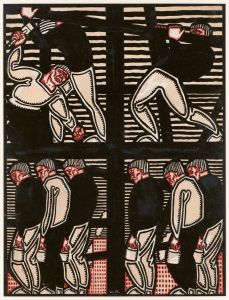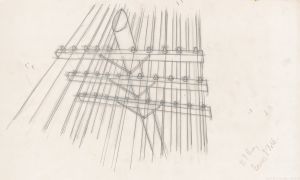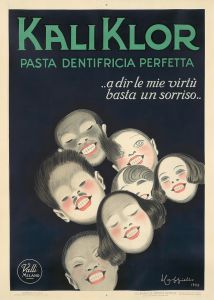
Design for unidentified caf ̌with green and yellow trim.] [Design with tulip stencils, upholstered bentwood chair in green and yellow color scheme
A hand-painted replica of Winold Reiss’s masterpiece Design for unidentified caf ̌with green and yellow trim.] [Design with tulip stencils, upholstered bentwood chair in green and yellow color scheme, meticulously crafted by professional artists to capture the true essence of the original. Each piece is created with museum-quality canvas and rare mineral pigments, carefully painted by experienced artists with delicate brushstrokes and rich, layered colors to perfectly recreate the texture of the original artwork. Unlike machine-printed reproductions, this hand-painted version brings the painting to life, infused with the artist’s emotions and skill in every stroke. Whether for personal collection or home decoration, it instantly elevates the artistic atmosphere of any space.
Winold Reiss was a German-American artist and designer known for his contributions to interior design and his vibrant use of color and pattern. Born in Karlsruhe, Germany, in 1886, Reiss immigrated to the United States in 1913. He brought with him a European sensibility that he combined with American themes, creating a unique style that was both modern and accessible. Reiss is particularly noted for his work in designing interiors for public spaces, including restaurants and cafes, where he applied his artistic vision to create immersive environments.
The design for an unidentified cafe with green and yellow trim, featuring tulip stencils and an upholstered bentwood chair in a green and yellow color scheme, is a testament to Reiss's innovative approach to interior design. This work exemplifies his ability to blend functionality with artistic expression, creating spaces that were not only visually appealing but also inviting and comfortable for patrons.
Reiss's use of color was one of his defining characteristics. In this particular design, the choice of green and yellow creates a lively and fresh atmosphere. Green is often associated with nature and tranquility, while yellow evokes warmth and energy. Together, these colors would have contributed to a welcoming and vibrant environment, encouraging social interaction and relaxation. The tulip stencils add an element of decorative art, reflecting Reiss's interest in integrating natural motifs into his designs. Tulips, with their simple yet elegant form, would have provided a subtle yet sophisticated decorative element, enhancing the overall aesthetic of the space.
The inclusion of an upholstered bentwood chair in the design highlights Reiss's attention to detail and his commitment to comfort. Bentwood furniture, known for its lightweight and durable construction, was a popular choice in the early 20th century for cafes and other public spaces. By upholstering the chair in the same green and yellow color scheme, Reiss ensured a cohesive look that tied the furniture to the overall design of the cafe. This attention to detail is indicative of Reiss's holistic approach to design, where every element is considered in relation to the whole.
Reiss's work in interior design was part of a broader movement in the early 20th century that sought to democratize art and make it a part of everyday life. By creating beautiful and functional public spaces, Reiss and his contemporaries helped to elevate the experience of dining and socializing, making it an art form in its own right. His designs were not just about aesthetics; they were about creating environments that enhanced the human experience.
Throughout his career, Reiss worked on numerous projects, including the design of the interiors for the iconic Apollo Theater in Harlem and the Longchamps restaurants in New York City. His work was characterized by a bold use of color, innovative use of materials, and a keen understanding of space and form. Reiss's legacy in the field of design is significant, as he helped to shape the visual culture of public spaces in America during the early 20th century.
In summary, Winold Reiss's design for an unidentified cafe with green and yellow trim, featuring tulip stencils and an upholstered bentwood chair, is a reflection of his artistic vision and design philosophy. Through his use of color, pattern, and form, Reiss created spaces that were not only aesthetically pleasing but also functional and inviting, leaving a lasting impact on the field of interior design.







![Graphic designs for Fortune magazine.] [Study for cover with large telephone lines superimposed over the globe](/imgs/249254/s/winold-reiss-graphic-designs-for-fortune-magazine-study-for-cover-with-large-telephone-lines-superimposed-over-the-globe-2de5efe.jpg)
![Designs for Shellball Apartments, 8300 Talbot St. at Lefferts Blvd., Kew Gardens, New York, NY.] [Perspective drawing of lobby](/imgs/249322/s/winold-reiss-designs-for-shellball-apartments-8300-talbot-st-at-lefferts-blvd-kew-gardens-new-york-ny-perspective-drawing-of-lobby-e19c70e0.jpg)
![Designs for theater with black-framed proscenium and boldly colored settings.] [Study for stage light wall decoration, Caf ̌Crillon](/imgs/249331/s/winold-reiss-designs-for-theater-with-blackframed-proscenium-and-boldly-colored-settings-study-for-stage-light-wall-decoration-caf-crillon-27adcd0f.jpg)
![Drawings for proposed decorations of Mike Lyman’s Restaurant, 424 W. Sixth St. Los Angeles, CA.] [Scheme 1; elevation – K – showing bar](/imgs/249336/s/winold-reiss-drawings-for-proposed-decorations-of-mike-lymans-restaurant-424-w-sixth-st-los-angeles-ca-scheme-1-elevation-k-showing-bar-6d934644.jpg)



![Designs for restaurant and bar interiors with curving bars and stairways.] [Sketches for bars and restaurants](/imgs/249417/s/winold-reiss-designs-for-restaurant-and-bar-interiors-with-curving-bars-and-stairways-sketches-for-bars-and-restaurants-195836c8.jpg)
![Miscellaneous small sketches for inlaid table tops.] [Design with orange and yellow geometric motif](/imgs/249438/s/winold-reiss-miscellaneous-small-sketches-for-inlaid-table-tops-design-with-orange-and-yellow-geometric-motif-9009d68a.jpg)


